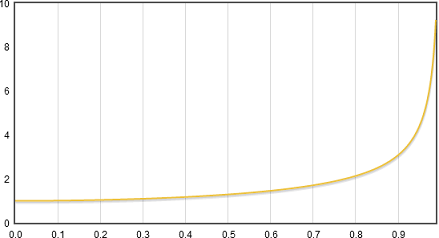It is a fact the conservation of momentum, for example when we play billiards and our
ball strikes others, the sum value of momentums must be conserved, ie if we call respectively \( \vec{p}, ;\ \vec{p'}\) to linear momentums before and after collision of the ball you have to
\( \sum_{i}\vec{p} = \sum_{i}\vec{p}' \; \Leftrightarrow \; \sum_{i}m_i\vec{v_i} = \sum_{i}m_i\vec{v_i}' \)
We'll see how, starting from these concepts (slightly redefined in special relativity)
and with math level high school student it is possible to obtain the most famous formula of science
E=mc2
Basic Concepts and principles
Extended Theory
In the theory of special relativity is replaced the velocity by
four-velocity and the linear momentum by
por el four-momentum .
Given a material particle moving with constant velocity v = (v1, v2, v3), then it is holds (x, y z) = vt and its universe line must be
\( \alpha(\tau)=(t(\tau), \vec{x}(\tau))= (t(\tau), \vec{v}t(\tau)) \)
To satisfy that α' be future and norm be 1 it is necessary
\( \displaystyle {\frac{dt}{d\tau}=\frac{1}{\sqrt{1-v^2}}=\gamma} \).
So
\( \vec{V}=\gamma(1,v_1,v_2,v_3) \)
\( \vec{P} = m \vec{V}= m\gamma(1,v_1,v_2,v_3) \)
as stated \( \displaystyle {\gamma =\frac{1}{\sqrt{1-v^2}}} \)
Note that four-momentum and four-velocity almost coincide in their last 3 coordinates with their respective analogues of classical mechanics, velocity and momentum respectively, but with a small modification factor (multiplication by γ) wich appears at Lorentz Transformation section.
In fact the last 3 coordinates of \( \vec{P} \) are called 3-momentum and we denote them by p.
The first coordinate of \( \vec{P} \) is called Energy and we denote it by E, therefore.
\( \vec{P} = (E, \vec{p} \), con \(E=\gamma m \) y \( \vec{p}=\gamma \vec{v} \)
From here it follows that
\( E= (m^2+||\vec{p}||^2)^{\frac{1}{2}} \)
In non-relativistic units it is
\( E= c(m^2 c^2 + ||\vec{p}||^2)^{\frac{1}{2}} \)
Making \( \vec{v} = 0 \) it is follows
Given a material particle moving with constant velocity v = (v1, v2, v3), then it is holds (x, y z) = vt and its universe line must be
\( \alpha(\tau)=(t(\tau), \vec{x}(\tau))= (t(\tau), \vec{v}t(\tau)) \)
To satisfy that α' be future and norm be 1 it is necessary
\( \displaystyle {\frac{dt}{d\tau}=\frac{1}{\sqrt{1-v^2}}=\gamma} \).
So
\( \vec{V}=\gamma(1,v_1,v_2,v_3) \)
\( \vec{P} = m \vec{V}= m\gamma(1,v_1,v_2,v_3) \)
as stated \( \displaystyle {\gamma =\frac{1}{\sqrt{1-v^2}}} \)
Note that four-momentum and four-velocity almost coincide in their last 3 coordinates with their respective analogues of classical mechanics, velocity and momentum respectively, but with a small modification factor (multiplication by γ) wich appears at Lorentz Transformation section.
In fact the last 3 coordinates of \( \vec{P} \) are called 3-momentum and we denote them by p.
The first coordinate of \( \vec{P} \) is called Energy and we denote it by E, therefore.
\( \vec{P} = (E, \vec{p} \), con \(E=\gamma m \) y \( \vec{p}=\gamma \vec{v} \)
From here it follows that
\( E= (m^2+||\vec{p}||^2)^{\frac{1}{2}} \)
In non-relativistic units it is
\( E= c(m^2 c^2 + ||\vec{p}||^2)^{\frac{1}{2}} \)
Making \( \vec{v} = 0 \) it is follows
\( E= m c^2 \)

|
|
Enegy growing with speed increases in relativistic units.
Note as Energy makes itself infinite when velocity tends to finite value of speed of ligth |
Note that γ is same γ of Lorentz Transformation (now expressed in relativistic units) and the value of E increasing as velocity increasing is
E → ∞ when||v|| → 1+
From here, it follows that when a material particle accelerates and increases its velocity to speed of light, its mass (and therefore its energy) tends to become infinite, hence it is not possible to accelerate a particle at the speed of light, because for this we need infinite energy.
With a considerable expenditure of energy we could accelerate a spaceship to 90% of speed of light, would be a good number, but we could never get to fully cover the 10% missing.


